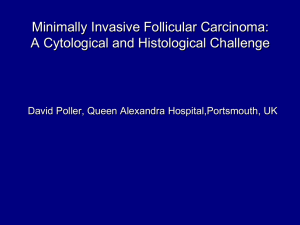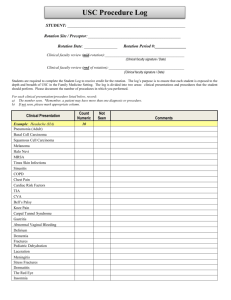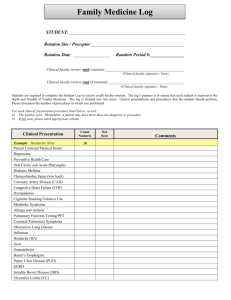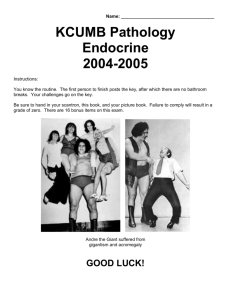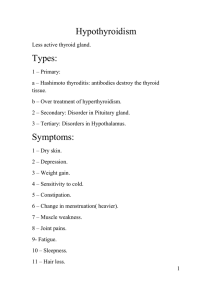ENT PATHOLOGY SERVICE (SHANDS AT UF): Rotation director
advertisement
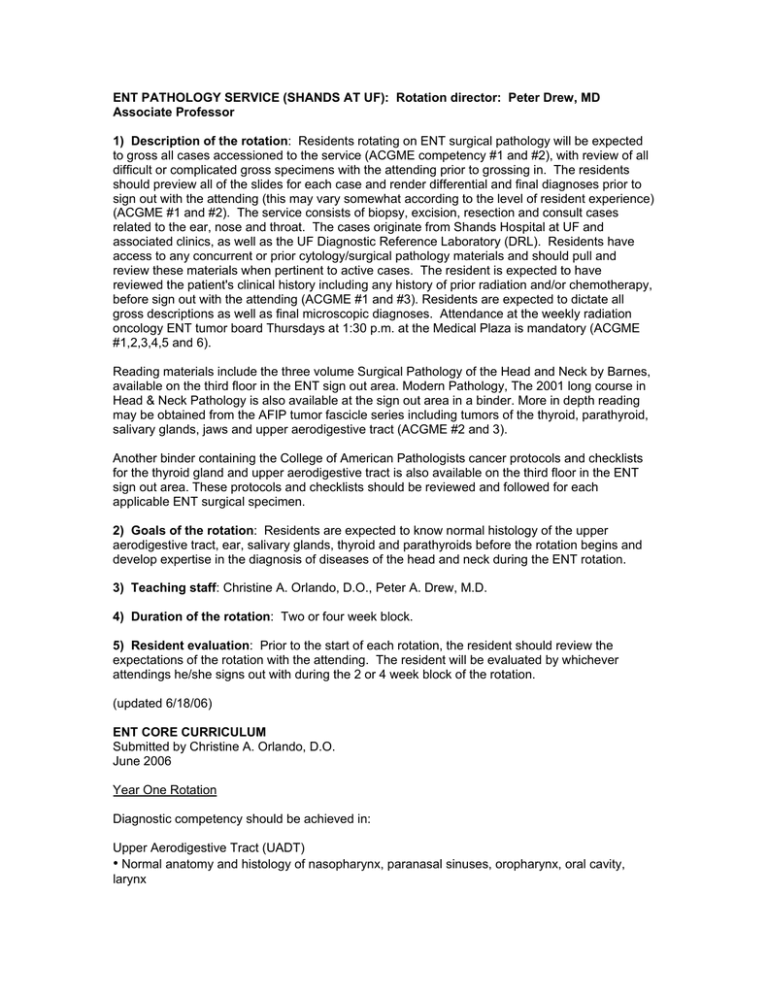
ENT PATHOLOGY SERVICE (SHANDS AT UF): Rotation director: Peter Drew, MD Associate Professor 1) Description of the rotation: Residents rotating on ENT surgical pathology will be expected to gross all cases accessioned to the service (ACGME competency #1 and #2), with review of all difficult or complicated gross specimens with the attending prior to grossing in. The residents should preview all of the slides for each case and render differential and final diagnoses prior to sign out with the attending (this may vary somewhat according to the level of resident experience) (ACGME #1 and #2). The service consists of biopsy, excision, resection and consult cases related to the ear, nose and throat. The cases originate from Shands Hospital at UF and associated clinics, as well as the UF Diagnostic Reference Laboratory (DRL). Residents have access to any concurrent or prior cytology/surgical pathology materials and should pull and review these materials when pertinent to active cases. The resident is expected to have reviewed the patient's clinical history including any history of prior radiation and/or chemotherapy, before sign out with the attending (ACGME #1 and #3). Residents are expected to dictate all gross descriptions as well as final microscopic diagnoses. Attendance at the weekly radiation oncology ENT tumor board Thursdays at 1:30 p.m. at the Medical Plaza is mandatory (ACGME #1,2,3,4,5 and 6). Reading materials include the three volume Surgical Pathology of the Head and Neck by Barnes, available on the third floor in the ENT sign out area. Modern Pathology, The 2001 long course in Head & Neck Pathology is also available at the sign out area in a binder. More in depth reading may be obtained from the AFIP tumor fascicle series including tumors of the thyroid, parathyroid, salivary glands, jaws and upper aerodigestive tract (ACGME #2 and 3). Another binder containing the College of American Pathologists cancer protocols and checklists for the thyroid gland and upper aerodigestive tract is also available on the third floor in the ENT sign out area. These protocols and checklists should be reviewed and followed for each applicable ENT surgical specimen. 2) Goals of the rotation: Residents are expected to know normal histology of the upper aerodigestive tract, ear, salivary glands, thyroid and parathyroids before the rotation begins and develop expertise in the diagnosis of diseases of the head and neck during the ENT rotation. 3) Teaching staff: Christine A. Orlando, D.O., Peter A. Drew, M.D. 4) Duration of the rotation: Two or four week block. 5) Resident evaluation: Prior to the start of each rotation, the resident should review the expectations of the rotation with the attending. The resident will be evaluated by whichever attendings he/she signs out with during the 2 or 4 week block of the rotation. (updated 6/18/06) ENT CORE CURRICULUM Submitted by Christine A. Orlando, D.O. June 2006 Year One Rotation Diagnostic competency should be achieved in: Upper Aerodigestive Tract (UADT) • Normal anatomy and histology of nasopharynx, paranasal sinuses, oropharynx, oral cavity, larynx • Squamous carcinoma- its precursors, grading of and variants (including verrucous, basaloid, lymphoepithelioma and spindle cell) • Nasal polyps, vocal cord polyps/nodules • Pyogenic granuloma Thyroid • Normal histology - follicular epithelium, C cells and their normal location in the gland, colloid and its composition •Hashimoto's thyroiditis and the use of clinical antibodies • Goiter/adenomatous hyperplasia • Dominant nodule in adenomatous hyperplasia versus follicular adenoma • Follicular adenoma versus follicular carcinoma • Follicular carcinoma- minimally versus widely invasive • Papillary thyroid carcinoma – classic and follicular variants Parathyroid • Embryology and descent of the superior and inferior parathyroid glands and the variations in final location and number of glands • Normal gross appearance including color, size and weight • Normal histology including fat to chief cell ratios and variations with age, clear and oncocytic cell change • Primary vs secondary vs tertiary hyperparathyroidism and the distribution of parathyroid hyperplasia vs adenoma vs carcinoma seen in each • Parathyroid hyperplasia vs adenoma vs carcinoma and intraoperative consultation Salivary gland • Normal histology of the three major and the minor salivary glands • Classification and grading of salivary gland neoplasms • Site specificity of salivary gland neoplasms • Some common neoplasms including Warthin's tumor, pleomorphic adenoma, mucoepidermoid carcinoma • Sialadenitis and sialadenosis Ear • Normal histology of external ear canal, tympanic membrane and middle ear • Cholesteatoma vs cholesterol granuloma vs inflammatory (aural) polyps Year two rotation Diagnostic competency should be achieved in: UADT • HPV and its role in lesions of the UADT • Laryngeal papillomatosis • Schneiderian mucosa, Schneiderian papillomas (vs nasal vestibule squamous papillomas) • Laryngeal squamous carcinoma- supraglottic vs glottic vs subglottic and the various spread patterns Thyroid • Variants of PTC including tall cell variant and its prognostic consequences • Anaplastic thyroid carcinoma • Medullary carcinoma and MEN syndromes • Lymphoma (MALToma) • Hurthle cell lesions Salivary gland • Adenocarcinoma NOS, adenoid cystic carcinoma (and its behavioral differences from other salivary gland neoplasms), PLGA, acinic cell carcinoma • Carcinoma ex pleomorphic adenoma • Primary squamous cell vs metastatic • Poorly differentiated squamous carcinoma vs high grade mucoepidermoid • Sjogren's syndrome/BLEL/MALTomas Ear • Jugulotympanic paraganglioma (Glomus tumor) • Middle ear adenoma Tympanosclerosis Otosclerosis Years three and four Diagnostic competency should be achieved in: UADT • SNUC vs olfactory neuroblastoma (ethesioneuroblastoma) • Verrucous hyperplasia vs verrucous carcinoma/PVL • Nonsalivary gland adenocarcinomas • Sinonasal melanoma • Sinonasal hemangiopericytoma and its differences from soft tissue HPC • Carotid body paragangliomas • Rhabdomyosarcoma in the head and neck • Nasopharyngeal angiofibroma Choanal polyp Thyroid • Poorly differentiated/insular carcinoma • Intraoperative consultation of thyroid lesions and the therapeutic implications Salivary gland • Necrotizing sialometaplasia • Cysts • Basaloid neoplasms including adenoid cystic carcinoma vs basal cell adenoma vs basal cell adenocarcinoma • Basal cell adenoma vs canalicular adenoma • Salivary duct carcinoma Ear • Ceruminal neoplasms • Aggressive papillary tumor of temporal bone and endolymphatic sac • Meningioma of temporal bone • Rhabdomyosarcoma of middle ear
